
This next section is dedicated to addressing the various hardware features available on your Apple devices: where they are located, what they are used for, and how to use them effectively. Depending on the model of your device, some of these sections may not be applicable to your user experience. For example, if you have an iPhone X, the section on the home button will not apply, as your phone does not have one. Vice versa, if you are using an iPhone SE or iPhone 8, the FaceID camera section will not apply to your device either, as it lacks that component.
Volume and Power
Regardless of the model of your device, it will come with three key hardware components: a ringer switch, a volume up, a volume down and a power button. The ringer switch and volume buttons will be on the left hand side of the phone, towards the top of the device. The ringer switch will be the topmost button, followed by the volume up and then the volume down button. The power button will be on the upper right hand side of the device.
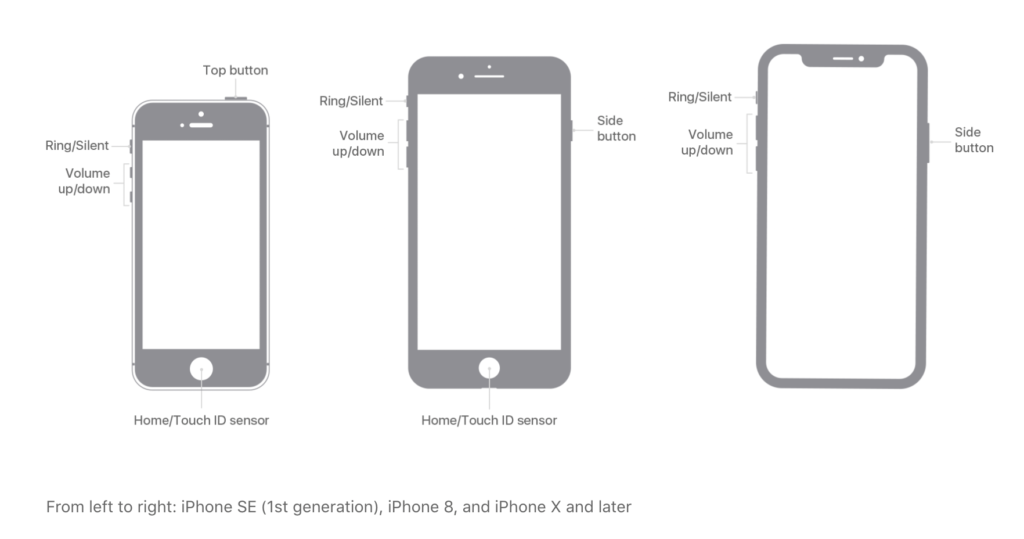
Note: iPhones 5 and older will have the power button on the top right corner of the phone, rather than on the right hand side of the device. Additionally, certain iPad models have different locations for this buttons as well. A good rule of thumb is that if your iPad does not have a home button, the power button will be on the top right of the device, and the volume up and down buttons will be on the right hand side of the device.
The ringer switch allows you to either turn on or turn off silent mode. This means that when the ringer switch is in the “on” position, your alert notifications will not only vibrate but ring as well. You can determine if your ringer is turned on by checking the switch itself, if you see an orange strip between the switch and the enclosure, this means that silent mode is turned on, and your phone will only vibrate when you receive any notifications; if you do not see the orange strip, then your phone will audibly ring.
The volume up and down buttons allow you to adjust the volume on any videos or music, and if you are connected to a speaker or headphones, the volume buttons can then be used to adjust the volume on that accessory.
The power button allows you to both turn the device on and off, as well as to lock the phone when it is not being actively used. To turn on the device, simply press and hold the power button until you see the Apple logo appear, after which you may release the device. Depending on the model of your device, there are several different ways to turn off your phone. If you have an iPhone X or newer – any model that does not have a home button – to turn off the device you will want to press and hold either the volume up or the volume down button as well as the power button. If you have an iPhone 8 or older – any model that does have a home button – simply press and hold the power button. For both types of devices you will want to hold down until you are presented with the “swipe to power off” screen, from there simply drag your finger across the slider, and the phone will power down.
Sometimes you may notice your phone has frozen or is running slow, or you may need to power off the device, but the display isn’t working so you can’t power off the device. If this is the case, we recommend the hard restart option. A hard restart forces the phone to power off completely before automatically restarting and restoring power. The phone fully powers off for about ten seconds before rebooting. In order to perform a hard restart, you will need to follow the shortcut below for your device:
iPhone 8 or newer : press and release volume up, then press and release volume down, then hold the power button until the screen goes black.
iPhone 7 or older: press and hold the volume down button and the power button until the screen goes black.
Home Button
While Apple has been phasing out the home button from their newer iPhones, it is still an essential component on both older models of iPhone and certain models of iPad. The home button allows you to quickly and efficiently return to the home screen of your phone by pressing the home button once, and in addition to this there are several shortcuts available that offer users several different options for navigation.
If you would like to see all applications currently open on your device, double-click the home button, and all of the applications will appear in order of most recently used. To close an application, simply swipe up on the image of the application.
To quickly enable your accessibility features, triple-click the home button, you can then turn off the accessibility features but triple-clicking the home button once more. For more information on accessibility features, including features available to various models of phone, how to set them up, and how to use them, see our deep dive
You can also access Siri from the home button. If you would like to prompt Siri to listen to your voice, press and hold the home button until Siri appears on the screen.
In iPhone 6 models and newer, there is also a feature called “Reachability” that allows you to temporarily reduce the image size of the display. This means that the length of the screen is halved, and the top of the screen now appears closer to the home button, making it easier to reach the corners of the display image without straining your thumb. To enable Reachability, double-tap the home button (tapping is different than clicking the button, simply place your finger on the home button twice in quick succession, without fully pressing down). To return to a normal screen, repeat this motion.
Home buttons also have a feature known as Touch ID, which allows you to unlock your phone using your fingerprint. TouchID is considered a supplemental log in feature, meaning you have to have a passcode or password enabled on your device in order to turn on Touch ID. A passcode is either a four or six digit numerical code, or a custom alphanumerical code, that must be entered before you can access any content on your device. We recommend setting up a passcode on your device, even if you do not intend to use Touch ID, as it is an effective way to protect your information in the event your phone is lost or stolen.
To turn on or set up a passcode for your device, follow these steps:
- Open Settings on your device, and scroll down and select “Touch ID and Passcode.”

- On the next screen, select “Turn Passcode On.”
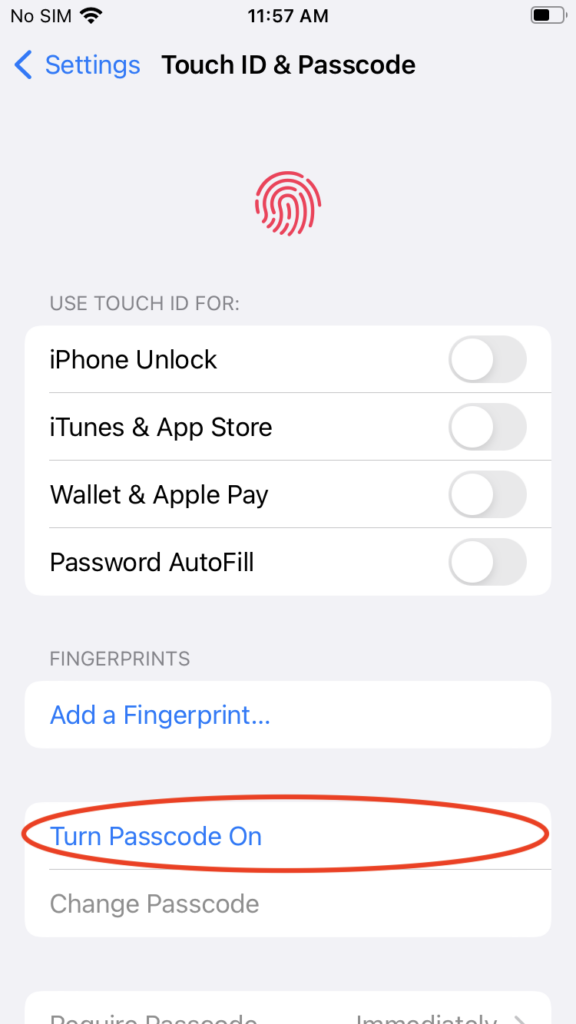
- On the next screen, you may enter a six digit passcode. If you would prefer a four digit passcode, or a custom alphanumeric or custom numeric passcode, select “Passcode Options” and then choose the passcode format that you would like.

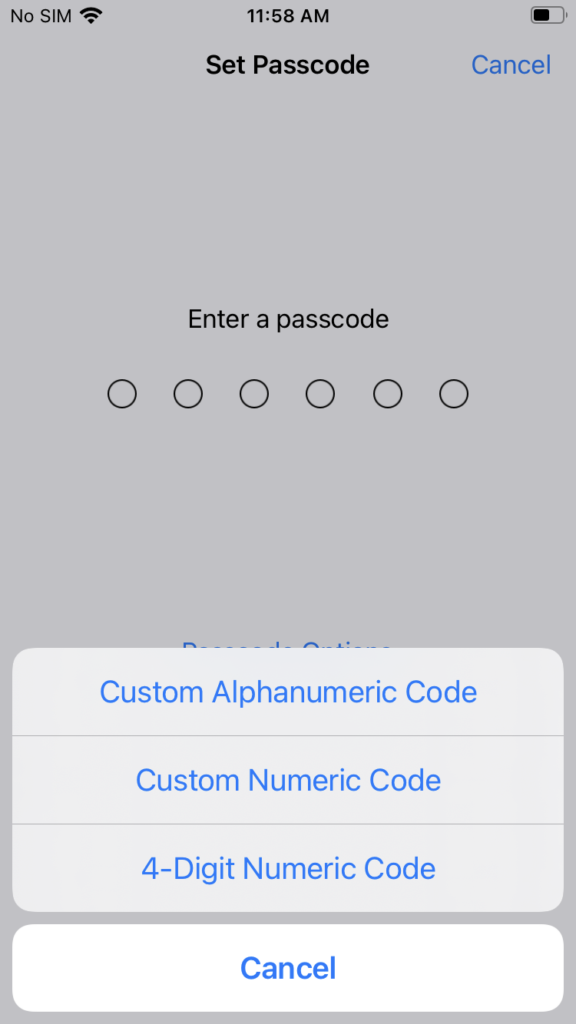
- Enter the passcode that you would like to use, then confirm it by entering it once more.
- Once this process has been completed, your phone will require a passcode to unlock.
To turn on Touch ID and set up a fingerprint, follow these steps:
- Open Settings on your device, and scroll down and select “Touch ID and Passcode.”
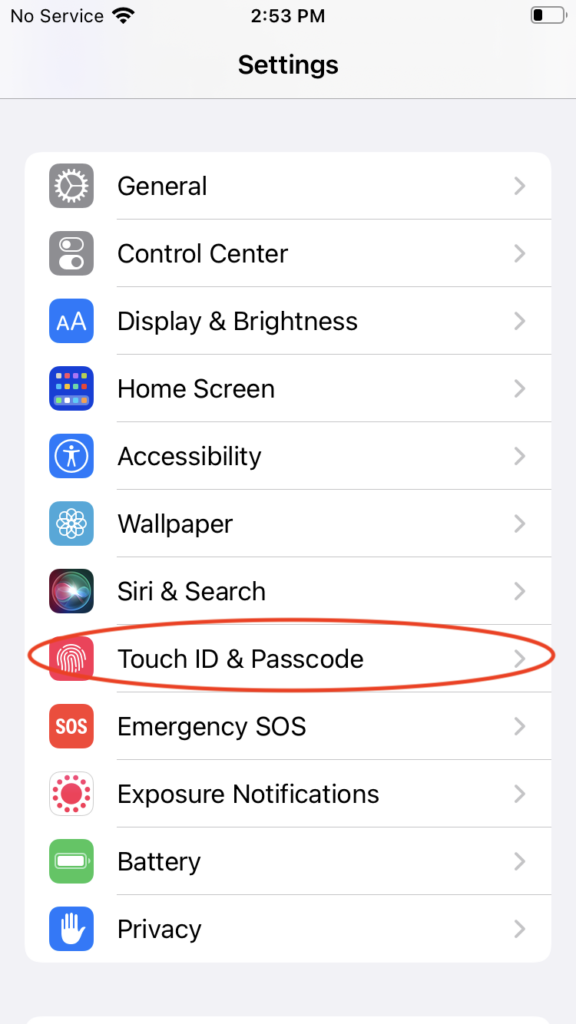
- If you have a passcode enabled on your device, you will have to enter it on the next screen.
- If you do not have a passcode enabled, you will have to turn it on and set up a passcode before you can turn on Touch ID. To do so, select “Turn Passcode On.” You may set up either a four-digit, six-digit, or custom alphanumeric passcode.
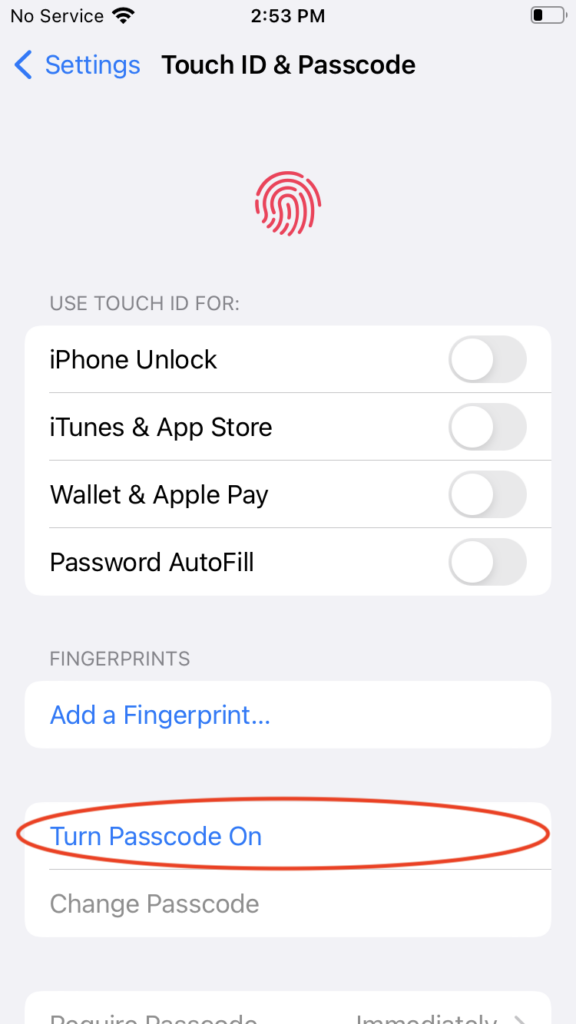
- Once you have turned on your passcode, you can then program Touch ID. To do so, select “Add Finergprint…” On the next screen you will be presented with a series of instructions, you will need to repeatedly place your finger on the home button – without physically pressing it – and lift your finger several times. Your phone will then prompt you to repeat this process while adjusting your grip, meaning you will be placing the edges of your finger onto the button before lifting, in order to ensure you have a comprehensive image of your print.
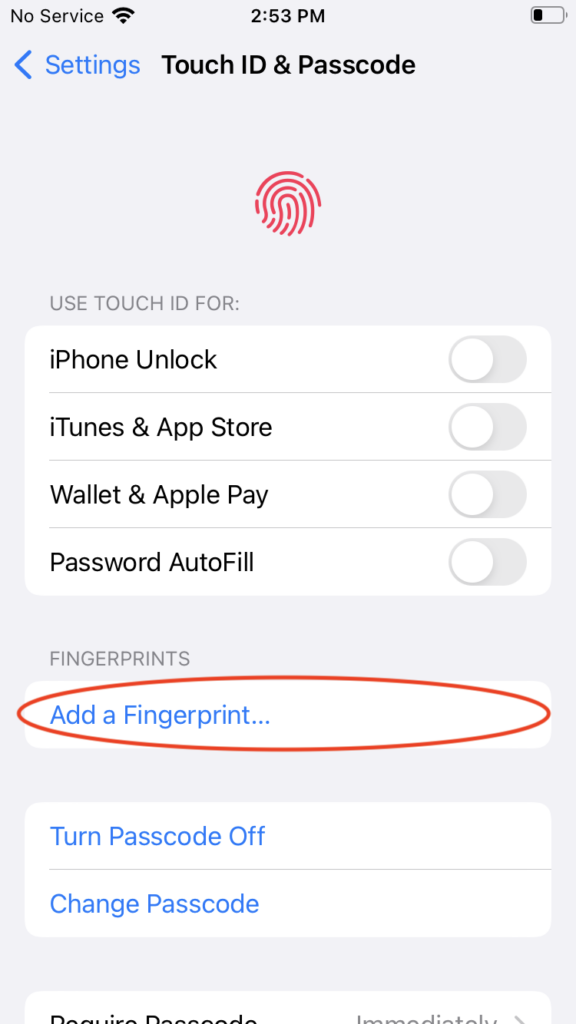
- Once you have completed this process, you will be able to unlock your phone using your fingerprint.
Takeaway: The buttons included in your device allow you to interact with the software of your machine. The buttons include the volume, ringer switch and power, and several combinations can allow you to power down the phone, adjust the volume of your ringer, or restart the device.
